Calgary, the Canadian city located in the province of Alberta, is home to a diverse variety of birds. Some are permanent residents, while others migrate to the region during the spring and fall seasons.
Bird-watching enthusiasts can find various species of birds in the city’s parks, natural reserves, and forests. The city’s diverse habitats offer a unique opportunity to observe birds in their natural setting.
This article will discuss some of the most common bird species that can be found in Calgary, their characteristics, and habitats. Whether you’re an avid bird-watcher or simply looking to enjoy nature, Calgary offers a unique and exciting experience for all.
1. Black-Capped Chickadee

The black-capped chickadee is a small and cheerful songbird found in deciduous and mixed forests across North America. It has an iconic black cap, white cheeks, gray back and wings with whitish bars on them.
The underparts are usually light colored or greyish brown. This species is well adapted to cold winters as it can reduce its body temperature by up to 8°C while roosting at night; this helps save energy during the colder months of the year.
It feeds mainly on insects but also eats seeds, fruits and suet from bird feeders when available.
Black-capped chickadees are popular birds among backyard visitors due to their sociable nature – they often establish lifelong partnerships with one another for breeding purposes.
Furthermore, they have been designated as state birds of Massachusetts and Maine in USA plus New Brunswick in Canada – a testament to how beloved these little avian friends truly are.Scientific classification:
| Kingdom | Animalia |
| Phylum | Chordata |
| Class | Aves |
| Order | Passeriformes |
| Family | Paridae |
| Genus | Poecile |
| Species | P. atricapillus |
Also Featured In: Most Common United States Birds, Most Common Winter Birds
2. Downy Woodpecker
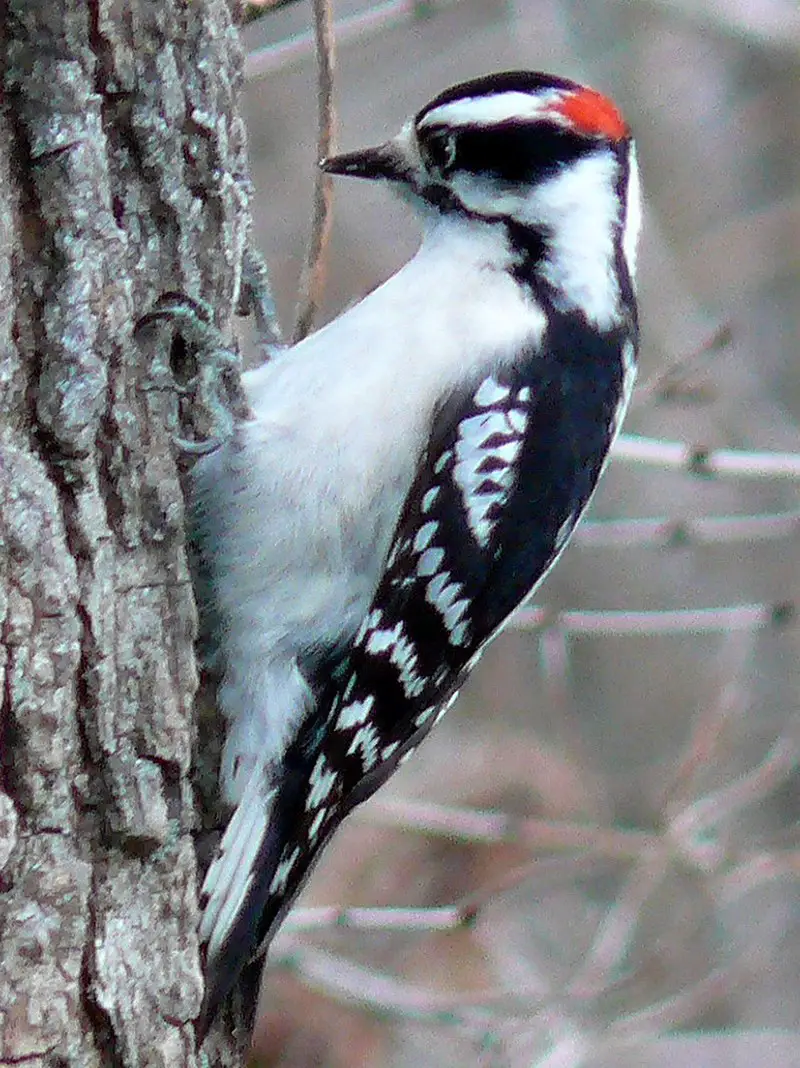
The downy woodpecker is a small species of woodpecker found in North America. Growing up to 7 inches long, it can be identified by its white belly and spotted wings.
It inhabits forests throughout the United States and Canada, with the exception of deserts in the southwest and northern tundra.
This bird nests in tree cavities and feeds mostly on insects but will supplement its diet with fruit or nuts when available.
The Downy Woodpecker has an unmistakable call that sounds like a loud ‘pik-er’, similar to other members of its family such as the Hairy Woodpecker.Scientific classification:
| Kingdom | Animalia |
| Phylum | Chordata |
| Class | Aves |
| Order | Piciformes |
| Family | Picidae |
| Genus | Dryobates |
| Species | D. pubescens |
Also Featured In: Long Island Birds You Should Know, Summer Birds that Live around Us
3. Ruffed Grouse
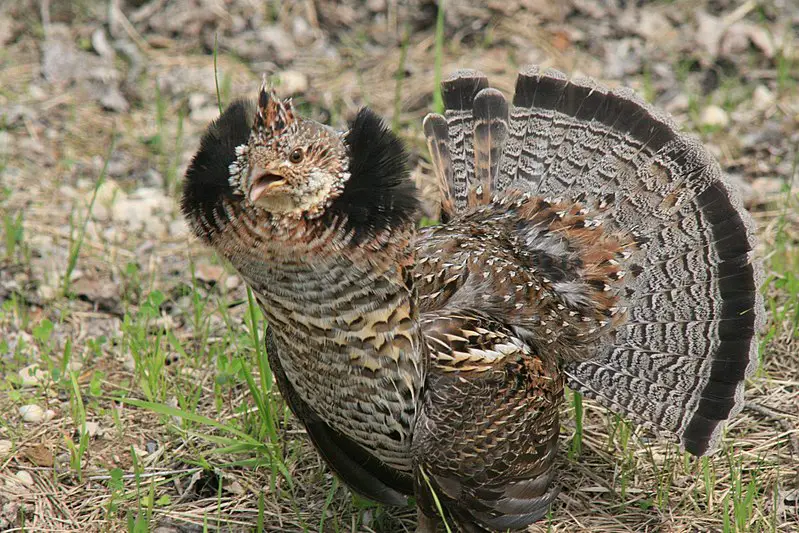
The Ruffed Grouse is a medium-sized bird native to forests from the Appalachian Mountains across Canada to Alaska.
It has an impressive range and is widely distributed throughout North America, making it one of the most abundant game birds in the region.
Unlike many other grouse species, this bird does not migrate and remains in its chosen habitat year round. The Ruffed Grouse has unique features that set it apart from similar birds.
Its feathers are ruffled like fur giving it a soft look; and its tail can be spread out into an umbrella shape when threatened or startled by predators.
This beautiful creature makes for great hunting opportunities with plenty of success stories among seasoned hunters – but only if they know what they’re doing.Scientific classification:
| Kingdom | Animalia |
| Phylum | Chordata |
| Class | Aves |
| Order | Galliformes |
| Family | Phasianidae |
| Tribe | Tetraonini |
| Genus | Bonasa Stephens, 1819 |
| Species | B. umbellus |
Also Featured In: Common Birds in Saskatchewan, Birds of Nova Scotia
4. American Coot
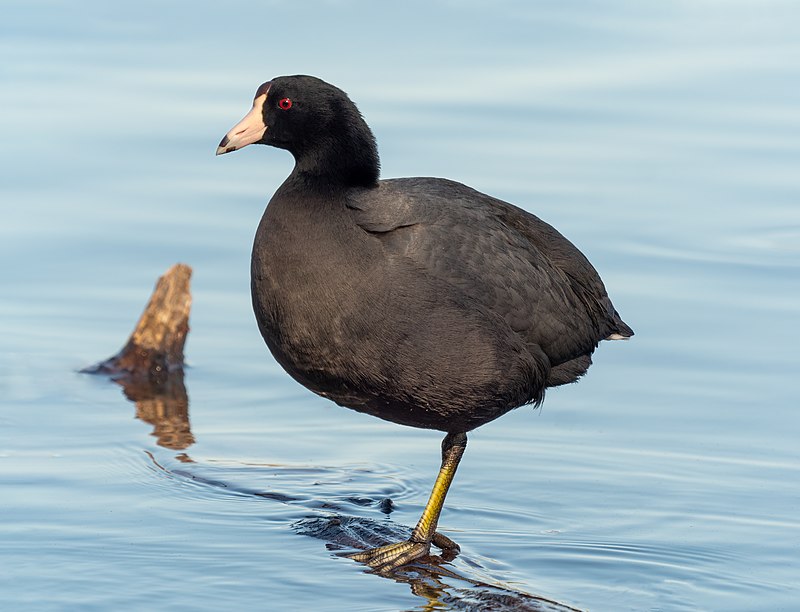
The American coot is a bird of the Rallidae family, commonly mistaken for ducks. However, they are only distantly related and have broad lobed scales on their lower legs and toes that fold back with each step to help them walk on dry land unlike ducks which have webbed feet.
Coots are omnivores who typically live in freshwater marshes, ponds and lakes but can also be found in brackish water habitats or even open oceans during migration season.
They feed mainly on algae and aquatic plants as well as small fish, snails, insects larvae and worms from time to time.
The males display territorial behaviour by chasing away intruders within their territory while females lay eggs mostly.
In floating nests made of vegetation near shorelines or islands among reeds where chicks hatch after about three weeks incubation period before swimming off into adulthood shortly afterwards at 10-12 weeks old.Scientific classification:
| Kingdom | Animalia |
| Phylum | Chordata |
| Class | Aves |
| Order | Gruiformes |
| Family | Rallidae |
| Genus | Fulica |
| Species | F. americana |
Also Featured In: Most Popular Bird Species in North America, Phoenix Birds You Should Know
5. Pied-Billed Grebe
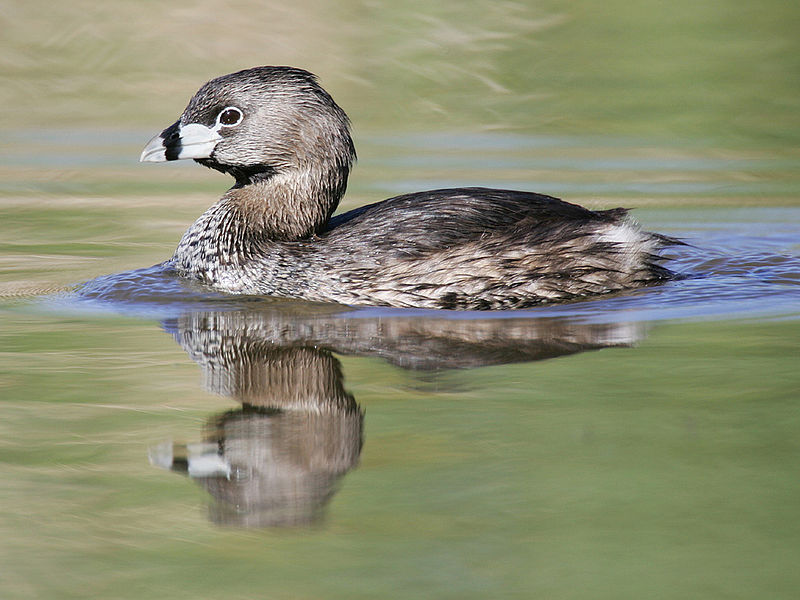
The Pied-billed Grebe is a water bird found in ponds throughout the Americas. It has earned many nicknames, including American dabchick, rail, and Carolina grebe.
This species of grebe can be recognized by its distinctive bill which is pied or mottled with black and white markings.
Its brownish body is also covered in dark spots as well as having long legs for swimming underwater to catch food such as aquatic insects and crustaceans.
The Pied-billed Grebes are monogamous birds that pair up during breeding season from spring to summer where they build their nests together on vegetation near the shoreline of lakes or slow moving rivers.
These birds are solitary outside of mating season but will form small flocks when migrating south for winter months.Scientific classification:
| Kingdom | Animalia |
| Phylum | Chordata |
| Class | Aves |
| Order | Podicipediformes |
| Family | Podicipedidae |
| Genus | Podilymbus |
| Species | P. podiceps |
Also Featured In: Top Birds Found in Mexico, Water Birds Live around Us
6. Lesser Yellowlegs
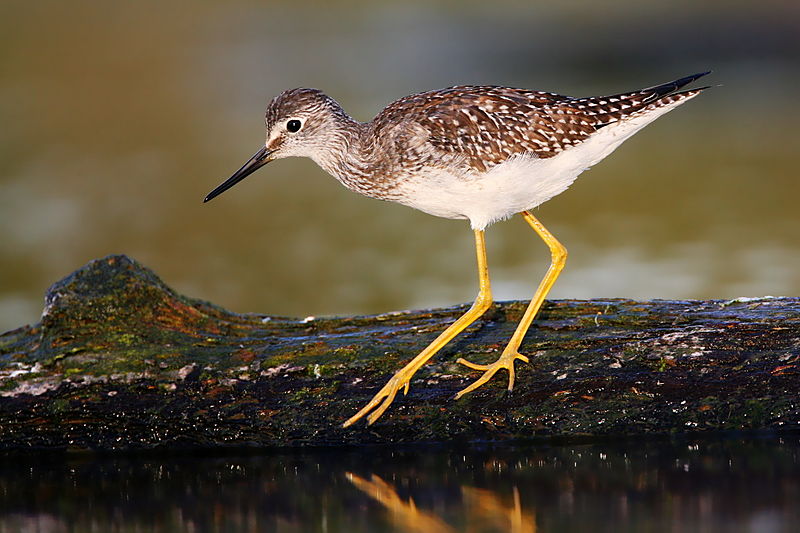
The Lesser Yellowlegs is a medium-sized shorebird found in the boreal forest region of North America.
It was described by German naturalist Johann Friedrich Gmelin in 1789 and placed it into the genus Scolopax.
This species has buff upperparts, white underparts, yellow legs and feet, olive green wings with white edges on its secondaries and tertials as well as a thin black bill which curves downward towards its tip.
The male lesser yellowlegs are slightly larger than females and can be distinguished from other waders due to their unique call; they will often make loud “tchew” or “churr” noises when alarmed during breeding season.
They typically feed on small aquatic insects such as beetles, flies, moths etc., but may also eat crustaceans such as shrimp or water snails if available.Scientific classification:
| Kingdom | Animalia |
| Phylum | Chordata |
| Class | Aves |
| Order | Charadriiformes |
| Family | Scolopacidae |
| Genus | Tringa |
| Species | T. flavipes |
Also Featured In: Most Common Oaxaca Birds, Common Birds in Prince Edward Island
7. Long-Billed Dowitcher
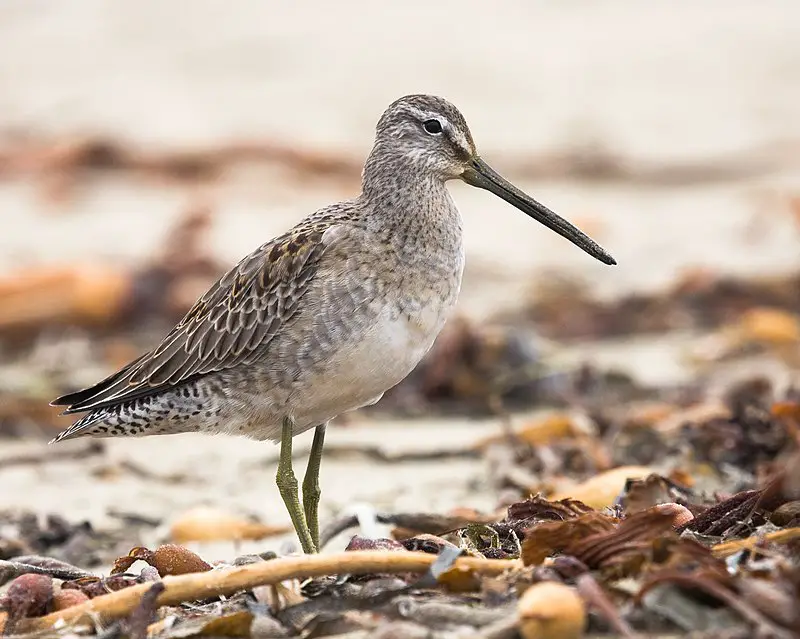
The Long-billed Dowitcher is a beautiful shorebird with an unmistakable long bill. During breeding season, they are characterized by their rufous head and underparts combined with a dark mottled back and large white upper rump only visible when in flight.
These birds can be found in freshwater habitats all over the world, where they forage underwater using their long bills to seek out aquatic invertebrates such as insects or small crustaceans.
They also feed on plant material like seeds and berries during times of scarcity.
The Long-billed Dowitcher is an important species for ecological balance due to its unique feeding habits that help control populations of certain insect pests, which makes it one of the most valuable bird species around us.Scientific classification:
| Kingdom | Animalia |
| Phylum | Chordata |
| Class | Aves |
| Order | Charadriiformes |
| Family | Scolopacidae |
| Genus | Limnodromus |
| Species | L. scolopaceus |
Also Featured In: Birds of Norfolk, Common Birds in London
8. Red-Breasted Nuthatch

The Red-breasted Nuthatch is a beautiful and vocal songbird that can be found in coniferous forests across Canada, Alaska, the northeastern United States and western US.
This small bird has blue-grey upperparts with cinnamon underparts, a white throat and face with black eye stripe, straight grey bill and black crown.
Its call sounds like a tin trumpet; it’s high-pitched yet nasal.
During mating season they form monogamous pairs to build their nest near tree trunks or branches at low heights off the ground where they lay 2 – 8 eggs at once.
They are very active little birds who love clinging to trees while searching for insect larvae or seeds within the bark of trees which helps control pest populations.Scientific classification:
| Kingdom | Animalia |
| Phylum | Chordata |
| Class | Aves |
| Order | Passeriformes |
| Family | Sittidae |
| Genus | Sitta |
| Species | S. canadensis |
Also Featured In: Common Birds in Canada, Blue Birds You’ll Found around Us
9. Spotted Sandpiper
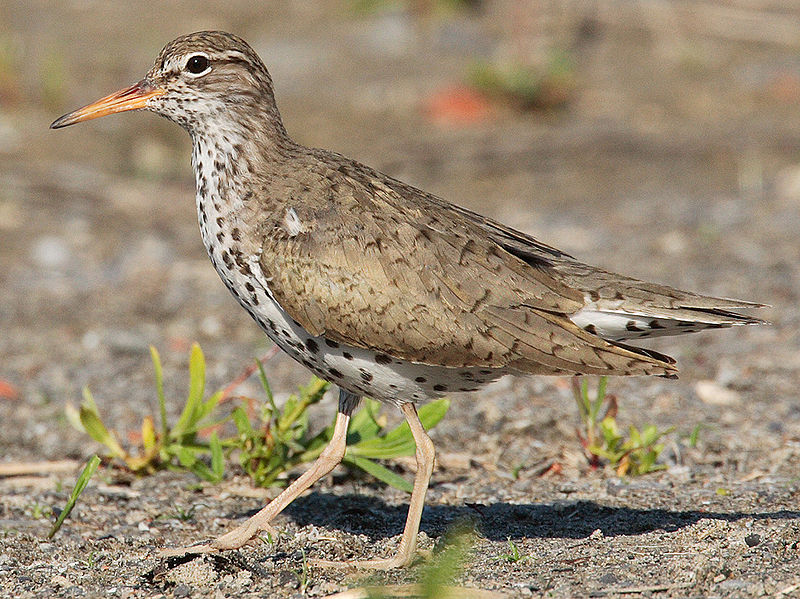
The Spotted sandpiper (Actitis macularius) is a small shorebird that can be found across North America and parts of South America.
It has an appealing spotted plumage, predominately brown in colour with white spots on the wings, tail feathers, head and neck.
The Common Sandpiper (A. hypoleucos) is its sister species which takes over geographically when the other moves away; they have been known to hybridize as well when strays settle down among breeders.
This bird was first described by Carl Linnaeus in 1766 in his twelfth edition of Systema Naturae as a migratory summer visitor to Europe but it now also occupies many habitats too like beaches, riversides and even grasslands during migration periods or for breeding season itself.
Its diet consists mainly of insects such as air-borne flies plus molluscs from shallow water areas – this makes them quite unique amongst waders.Scientific classification:
| Kingdom | Animalia |
| Phylum | Chordata |
| Class | Aves |
| Order | Charadriiformes |
| Family | Scolopacidae |
| Genus | Actitis |
| Species | A. macularius |
Also Featured In: Suriname birds, Birds that Live in Mississippi
10. Eastern Kingbird
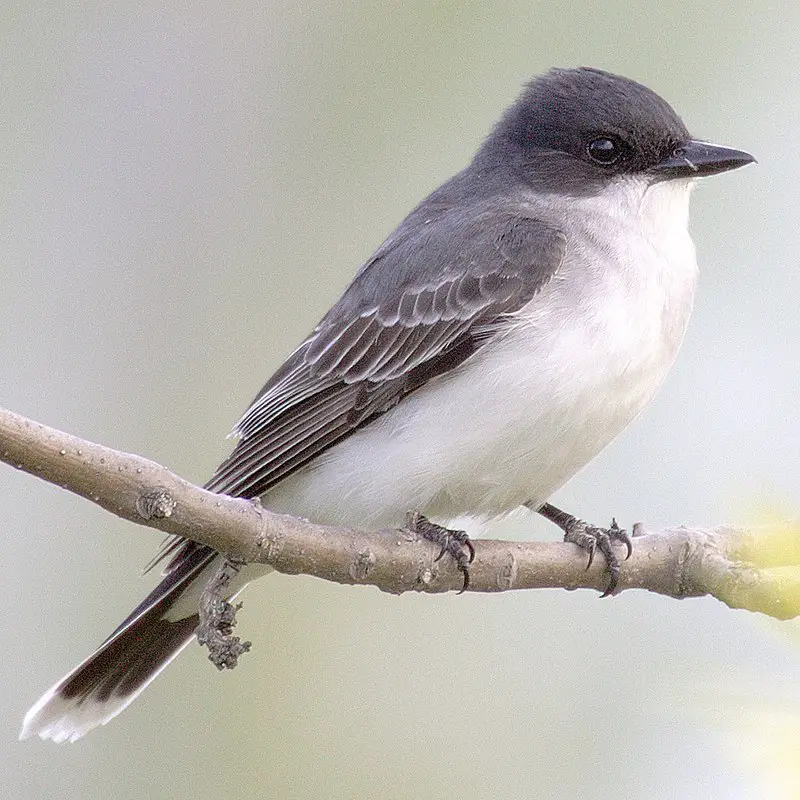
The Eastern kingbird is an impressive large grey bird, with a white underbelly and pointed wings. It can be seen perched atop trees or bushes in open areas while foraging for insects.
This species of tyrant flycatcher breeds across much of North America during the spring and summer months before migrating southwards come wintertime.
During this time, they have been known to travel as far south as Central and South America.
These birds are particularly territorial when nesting; having been observed chasing off even larger animals such as hawks away from their nests. A truly remarkable sight to behold.Scientific classification:
| Kingdom | Animalia |
| Phylum | Chordata |
| Class | Aves |
| Order | Passeriformes |
| Family | Tyrannidae |
| Genus | Tyrannus |
| Species | T. tyrannus |
Also Featured In: Flycatchers Species, Birds that You’ll Find in Puerto Rico
11. Harris’s Sparrow
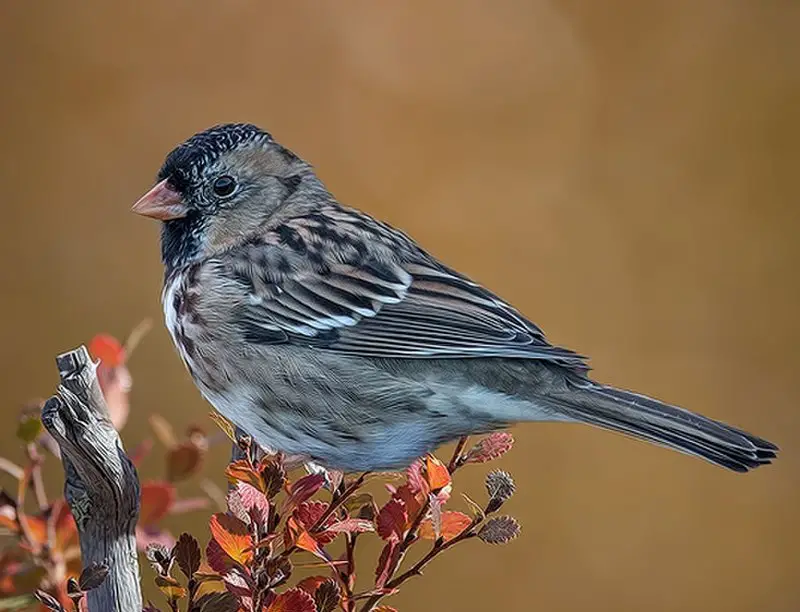
Harris’s sparrow is a large, distinctive bird that is endemic to Canada. It breeds in the north part of central Canada, mainly in Northwest Territories and Nunavut with its range extending into Manitoba and Saskatchewan.
During winter it migrates southward to states such as South Dakota, Texas or Nebraska where they can be found foraging on grasslands or prairies.
Its plumage includes white underparts with brown streaking on the sides accompanied by a grey-brown crown and black bill which makes it easy to identify.
Although not endangered yet due efforts should still be taken for conservation since their habitat loss has been affecting them adversely over time.Scientific classification:
| Kingdom | Animalia |
| Phylum | Chordata |
| Class | Aves |
| Order | Passeriformes |
| Family | Passerellidae |
| Genus | Zonotrichia |
| Species | Z. querula |
Also Featured In: Sparrows Species, Common Northwest Territories Birds
12. Townsend’s Solitaire
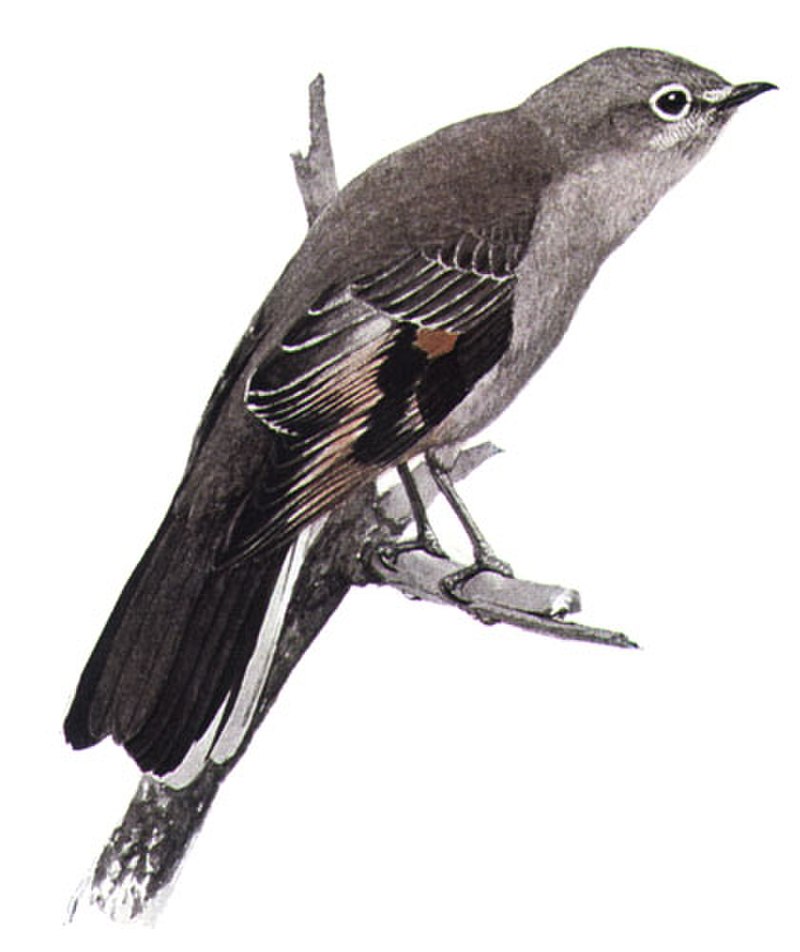
Townsend’s solitaire is a medium-sized thrush native to North America, ranging from Alaska and Canada all the way down to Zacatecas in Mexico.
It prefers montane woodlands but will travel for food during winter months – sometimes all the way down to Great Plains or desert oases.
This bird has distinct features such as grey upperparts with white spots on wings, buff underparts and light streaks on its head.
The Townsend’s Solitaire also makes an interesting sound – it produces melodic whistles which can be heard across long distances within forested areas.
Despite this birds beauty and song however, populations have been declining due largely to habitat destruction caused by logging activities.Scientific classification:
| Kingdom | Animalia |
| Phylum | Chordata |
| Class | Aves |
| Order | Passeriformes |
| Family | Turdidae |
| Genus | Myadestes |
| Species | M. townsendi |
Also Featured In: Thrush Species, Lake Tahoe Birds
13. Black-Billed Magpie
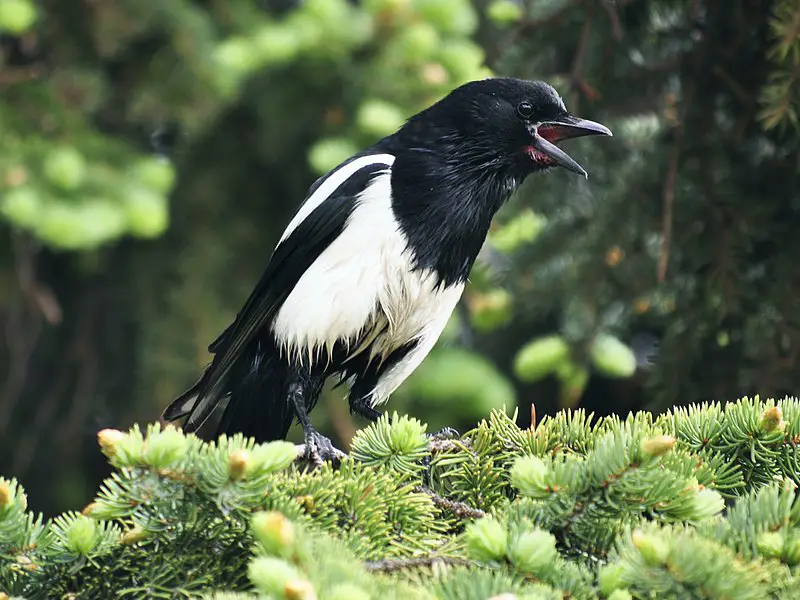
The black-billed magpie is an iconic bird of the western half of North America and one of only four songbirds with a tail that makes up over half its body length.
With its glossy black feathers offset by white patches, they can be seen in open woodlands or near agricultural areas.
Their diet consists mainly of insects, carrion and grains but they often scavenge human food as well.
They are highly social birds who live in large groups and communicate through loud calls, snaps and rattles when defending their territory from other airborne predators like hawks or eagles.
Magpies have proven to be hardy survivors despite habitat loss due to urbanization so there’s hope these remarkable birds will remain part our landscape for many years to come.Scientific classification:
| Kingdom | Animalia |
| Phylum | Chordata |
| Class | Aves |
| Order | Passeriformes |
| Family | Corvidae |
| Genus | Pica |
| Species | P. hudsonia |
Also Featured In: Utah Birds, Birds That Live in Colorado
14. American Yellow Warbler
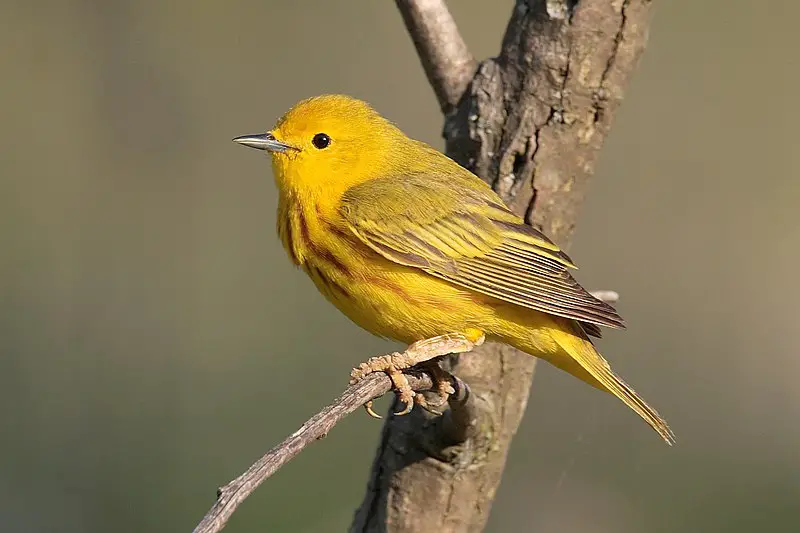
The American Yellow Warbler (Setophaga petechia) is a species of New World warbler found across North America, the Caribbean and into northern South America.
Its genus name Setophaga comes from Ancient Greek words meaning “moth” and “eating”, while its specific name Petechia originates from Italian for small red spots.
This bird has striking yellow plumage with reddish-brown streaks on their chest that can be seen during mating season when they are most colourful.
They live in open woodlands near wetlands or bodies of water where they can find food such as insects like spiders, beetles and caterpillars which make up much of their diet.
The male will sing to attract a mate during breeding season before setting up home in twig nests built by both sexes together high in trees or shrubs.Scientific classification:
| Kingdom | Animalia |
| Phylum | Chordata |
| Class | Aves |
| Order | Passeriformes |
| Family | Parulidae |
| Genus | Setophaga |
| Species | S. petechia |
Also Featured In: Most Common Songs Birds that Live around You, Birds Commonly Found in New York
15. Western Tanager
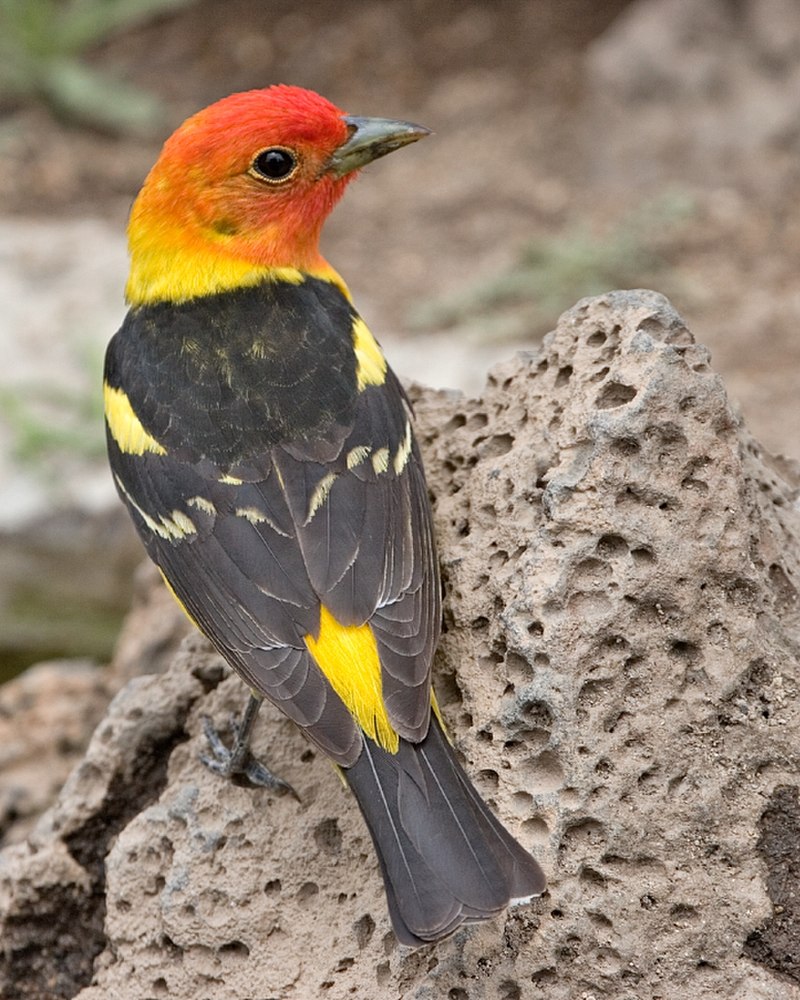
The Western Tanager (Piranga ludoviciana) is a medium-sized songbird belonging to the cardinal family, Cardinalidae. It was illustrated and formally described by American ornithologist Alexander Wilson in 1811.
The species has distinctive plumage including yellow feathers on its wings and tail, red shoulders, black head with white forehead patch and grayish underparts.
Its vocalizations are also very similar to other members of the cardinal family – they have a high pitched ‘tsee’ note followed by several sweeter notes that come together as parts of complex songs.
They primarily feed on fruit but will also take insects when available for extra protein during breeding season.
These beautiful birds can be found throughout western North America from Alaska down through Mexico making them an iconic part of many landscapes.Scientific classification:
| Kingdom | Animalia |
| Phylum | Chordata |
| Class | Aves |
| Order | Passeriformes |
| Family | Cardinalidae |
| Genus | Piranga |
| Species | P. ludoviciana |
Also Featured In: Birds that Found in the Yellowstone , Birds that Live in Yosemite National Park
16. Sharp-Shinned Hawk
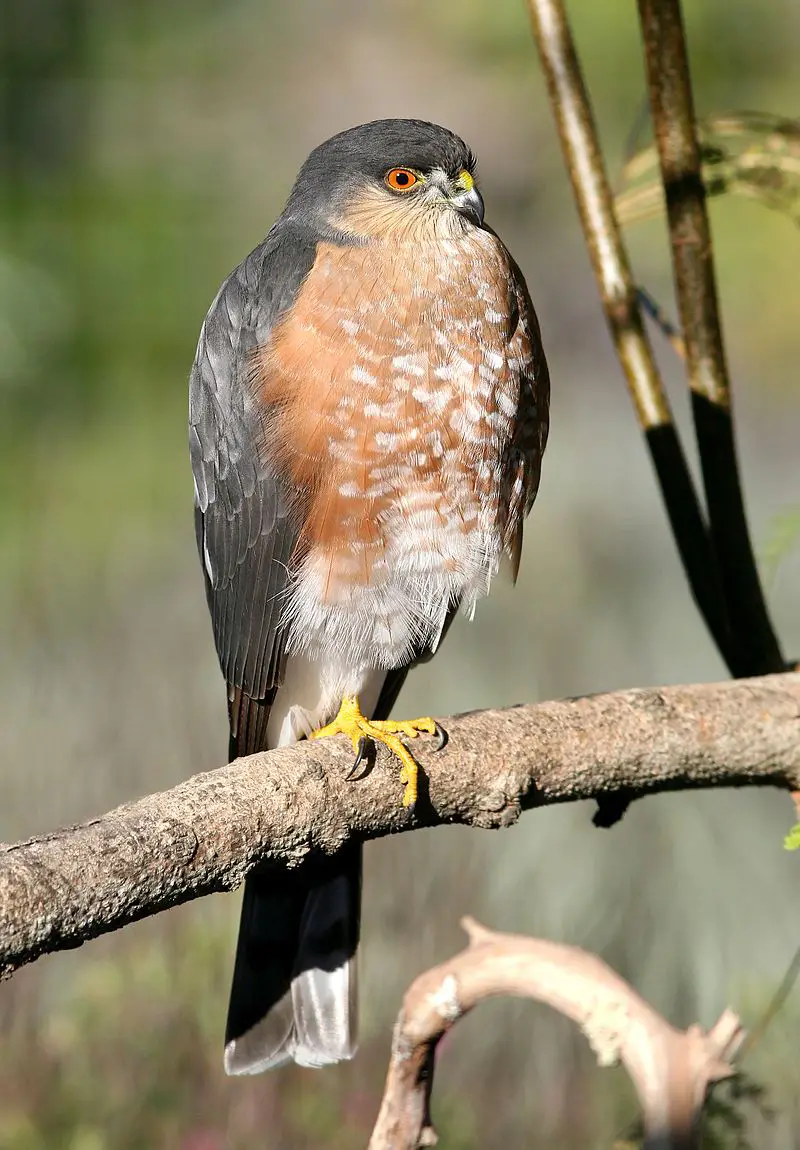
The Sharp-shinned Hawk is a small hawk found throughout the United States and Canada. It is one of the smallest hawks in North America, but larger than some Neotropical species such as the tiny hawk.
Taxonomy of this bird remains uncertain; with some authorities suggesting that southern taxa may represent three distinct species: white-breasted hawk (A. chionogaster), plain-breasted hawk (A. ventralis) and rufous morph sharp-shinnedhawk(A. rufiventris).
These birds feed primarily on small birds like finches, sparrows, woodpeckers and warblers while hunting from perches or by flying through dense vegetation to surprise unsuspecting prey items.
They are agile flyers that rely heavily on surprise to capture their food items quickly before they can fly away.Scientific classification:
| Kingdom | Animalia |
| Phylum | Chordata |
| Class | Aves |
| Order | Accipitriformes |
| Family | Accipitridae |
| Genus | Accipiter |
| Species | A. striatus |
Also Featured In: New Hampshire Birds You Should Know, Common Southern Californian Birds
17. Flickers
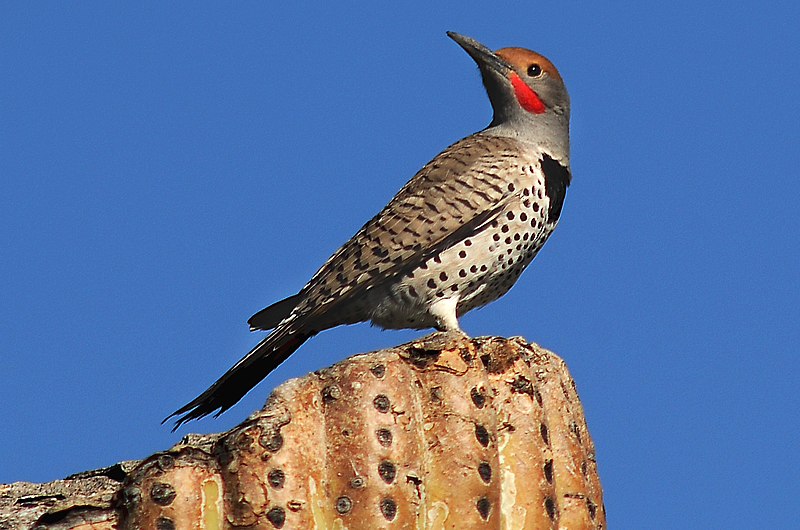
Flickers are birds of the Colaptes genus in the Picidae family, found across North and South America.
They typically have brown or green backs with black barring and beige to yellowish undersides with black spotting or barring.
Some species may also feature colorful markings on their heads, making them stand out from other woodpeckers.
Flickers live mostly on land rather than trees so they can easily forage for food such as beetles, ants and fruits – all important parts of their diet.
These medium-sized woodpeckers spend much of their time hopping around on branches looking for insects before taking a few pecks at tree trunks every now and then to tap into grubs hiding inside bark crevices.Scientific classification:
| Kingdom | Animalia |
| Phylum | Chordata |
| Class | Aves |
| Order | Piciformes |
| Family | Picidae |
| Tribe | Picini |
| Genus | Colaptes Vigors, 1825 |
Also Featured In: Alabama Birds,
18. Northern Flicker

The Northern flicker is a woodpecker species found in North America, Central America, Cuba, and the Cayman Islands. This medium-sized bird is known for its unique migration behavior.
Over 100 common names are used to refer to the Northern flicker, one of them being “yellowhammer”. It is a beautiful bird with distinctive markings and a colorful plumage.
The Northern flicker is an important species in its ecosystem and plays a key role in maintaining a healthy balance in the environment.
Despite being a woodpecker, the Northern flicker has a diverse diet that includes insects, fruits, and seeds.
It is fascinating to observe this bird as it pecks at trees in search of food, communicates with its unique vocalizations and performs its incredible aerial displays.
The Northern flicker is truly a remarkable bird species that is worthy of our admiration and protection.Scientific classification:
| Kingdom | Animalia |
| Phylum | Chordata |
| Class | Aves |
| Order | Piciformes |
| Family | Picidae |
| Genus | Colaptes |
| Species | C. auratus |
Also Featured In: Birds Live in Arkansas, Common Birds in the Cities
19. Red-Necked Grebe
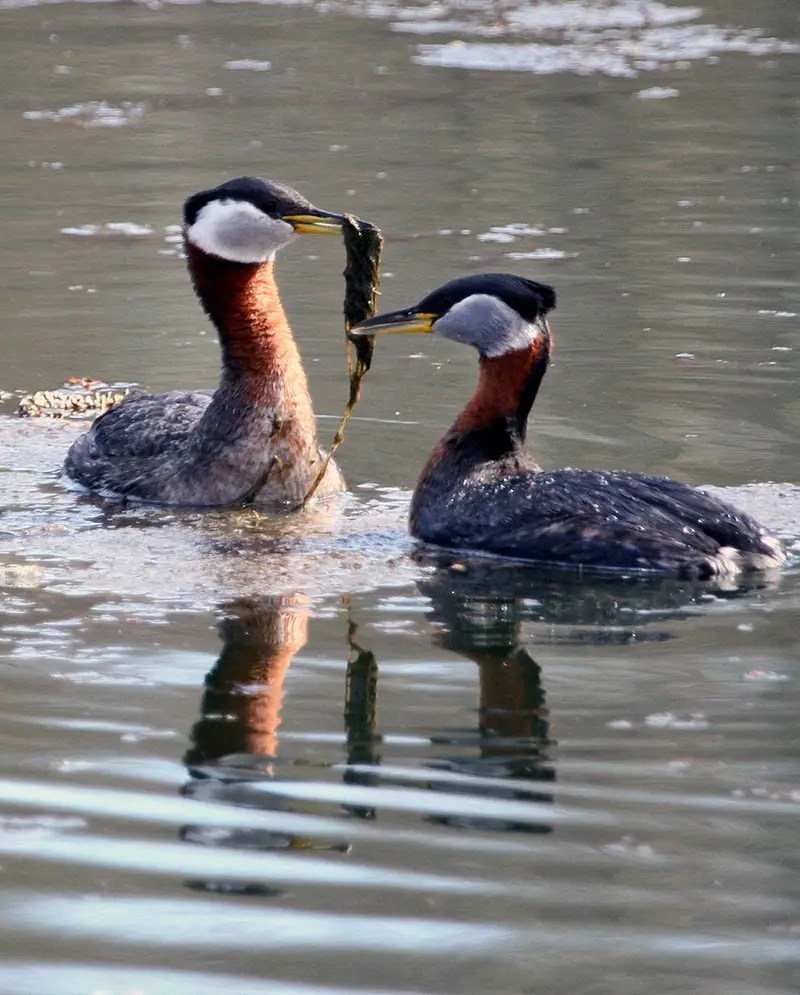
Red-necked grebe, also known as Podiceps grisegena, is a migratory aquatic bird that can be found in the temperate regions of the northern hemisphere.
During the winter, they prefer calm waters beyond the waves near ocean coasts or large lakes.
In terms of breeding, these birds breed in shallow bodies of fresh water like lakes, marshes, or fish-ponds.
They are not dependent on specific habitats but seem to prefer areas that provide them with enough food supplies.
These birds are known for their unique red neck and prefer to swim underwater when threatened.
Overall, the Red-necked Grebe is an interesting and unusual bird with distinct physical characteristics and behaviors.Scientific classification:
| Kingdom | Animalia |
| Phylum | Chordata |
| Class | Aves |
| Order | Podicipediformes |
| Family | Podicipedidae |
| Genus | Podiceps |
| Species | P. grisegena |
Also Featured In: Native Birds of Kazakhstan, Common Estonian Birds
20. Solitary Sandpiper
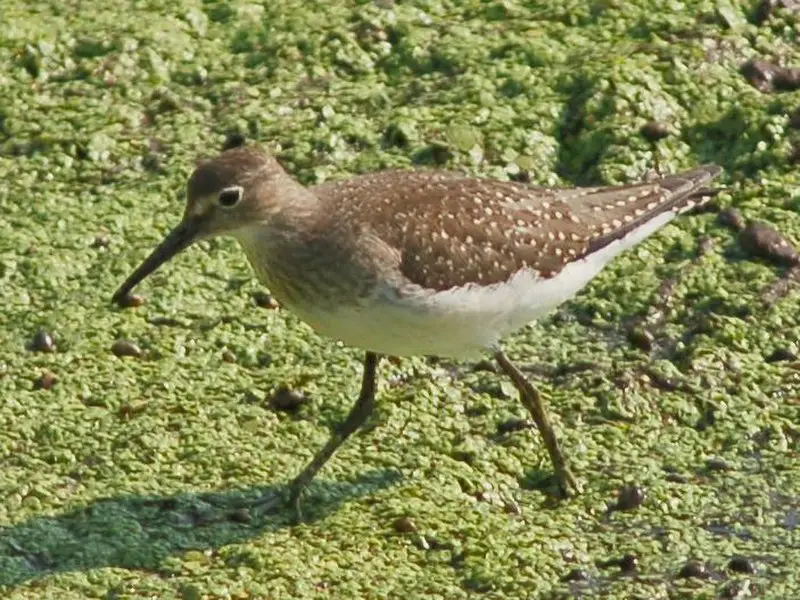
The Solitary sandpiper is a small shorebird that belongs to the Tringa genus. Its scientific name is Tringa solitaria, which means “solitary” in Latin. It measures 18-23 cm in length and has a distinct white-rumped tail.
The name Tringa comes from Ancient Greek trungas, which refers to a thrush-sized wading bird.
The Solitary sandpiper is named so because it is often found alone. It is a migratory bird that breeds in North America and winters in South America.
Its diet consists of insects, crustaceans, and small fish, which it picks up using its long, thin bill. Despite its name, this bird is not entirely solitary and has been known to feed and roost with other shorebirds.
The Solitary sandpiper is a unique and fascinating species that can be found in wetland habitats across North and South America.Scientific classification:
| Kingdom | Animalia |
| Phylum | Chordata |
| Class | Aves |
| Order | Charadriiformes |
| Family | Scolopacidae |
| Genus | Tringa |
| Species | T. solitaria |
Also Featured In: Common Central Park Birds, Birds that Migrate through Illinois in the Spring
21. Northern Shrike
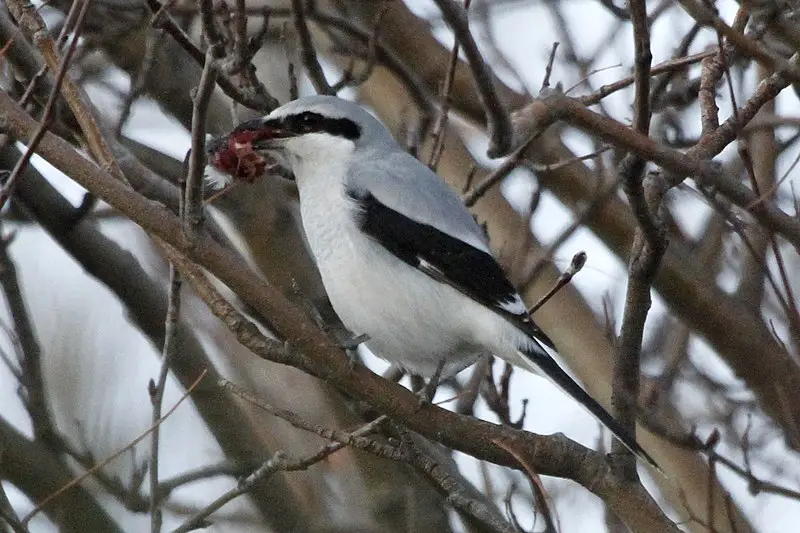
The northern shrike, also known as Lanius borealis, is a songbird species categorized under the shrike family. It is native to North America and Siberia and was previously classified as a subspecies of the great grey shrike.
However, it was recognized as a distinct species in 2017. Currently, there are six identified subspecies of the northern shrike.
This bird species was officially described by Louis Jean Pierre Vieillot, a French ornithologist, in 1808.
It is a relatively large bird with a fascinating predatory behavior of impaling its prey on thorns or barbed wire fences.
The northern shrike’s popularity in birdwatching is due to its striking appearance with a black mask and grayish-brown back and wings.Scientific classification:
| Kingdom | Animalia |
| Phylum | Chordata |
| Class | Aves |
| Order | Passeriformes |
| Family | Laniidae |
| Genus | Lanius |
| Species | L. borealis |
Also Featured In: Birds You’ll Find in Vancouver Island, Winter Birds of Illinois